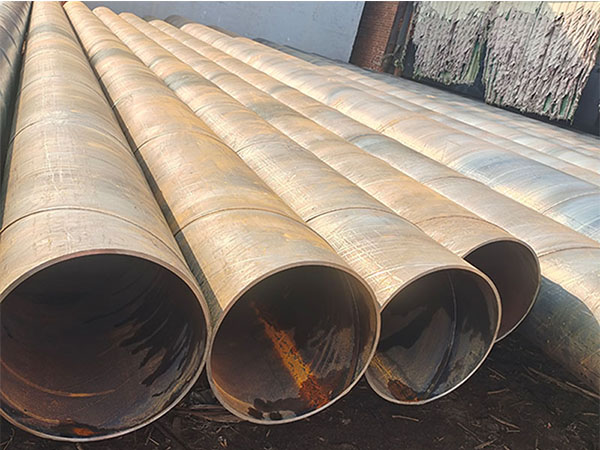LSAW and SSAW are two common manufacturing processes for welded steel pipes. LSAW stands for Straight seam Submerged arc welded steel pipe, while SSAW stands for spiral seam submerged arc welded steel pipe. Next, CENTRAL STEEL will further explore LSAW and SSAW steel pipes from aspects such as definition, production process and performance.
What are LSAW pipes and SSAW pipes?
LSAW steel pipes are formed by bending steel plates in molds and welding them. The weld seams are straight, thus featuring high strength and good straightness. This process is often used to manufacture large-diameter and thick-walled steel pipes and is widely applied in fields such as oil and gas transportation and structural support.
SSAW steel pipes are made by rolling steel coils into a spiral shape and then performing submerged arc welding, with the weld seam being spiral. This process has high flexibility and is capable of producing steel pipes of various diameters, with relatively low production costs. SSAW steel pipes are widely used in oil, natural gas, water supply and drainage systems.

Comparison of manufacturing processes
LSAW: Usually, a whole medium and thick steel plate is bent into a cylinder through the JCOE or UOE process, and then welded along the axial direction (the weld seam is a straight line).
Detailed manufacturing process: Plate UT→Size And Appearance Inspection→The Electromagnetic Hanging →Tab Welding→Ultrasonic Inspection→Edge Milling→Pre-Bending→Type J Forming→Type C Forming→Type O Forming→Tack Welding By CO₂ Gas Shield Arc Welding→Tack Welding and Check the Repair→Inside Welding→Rust Removal→Washing After Expansion→Weld Grinding for Pipe Ends→Use Flame Repair→Mechanical Expansion→Washing Before Expansion→Cleaning→Outside Welding→Removal of Tab Plate→X-Ray Test→Ultrasonic Testing→Hydrostatic Test→Ultrasonic Testing→X-ray Photographic→Rounding and Straightness→Mechanical Facing→Magnetic Particle Inspection for Both Ends→Product Inspection→Weighing and Measuring Length→Inside Coating→Outside Coating→Marking→Packing and Warehousing
SSAW: Roll the steel strip into a spiral shape along the square where the steel strip is rolled
The dimensions are welded in the opposite direction, and the weld seam is formed by covering multiple circles along the spiral direction.
Detailed manufacturing process: Uncoiling→Flattening→Shearing and Butt Welding→Edge Milling→Preliminary Rolling→Forming→Inside and Outside Welding→Cutting Off→Ultrasonic Testing→Ultrasonic Inspection→X-Ray Test→Weld Grinding for Pipe Ends→Expanding at Pipe Ends→Hydrostatic Test→X-Ray Test→Pipe Ends Beveling→Product Inspection→Marking→Warehousing
than
The diameter range of LSAW pipes is typically 16 inches to 60 inches (406.4 mm to 1524 mm), with a wall thickness of 6 mm to 50 mm. They can be made into thicker billets and are suitable for high-pressure requirements.
The diameter range of SSAW pipes is typically 20 inches to 100 inches (508 millimeters to 2540 millimeters), and the wall thickness is 6 millimeters to 25 millimeters. It can manufacture super-large diameter steel pipes, which are very suitable for use in water supply and structural support and other fields.
Comparison of weld quality and performance
The welds of LSAW steel pipes are axial straight welds, and the welds are usually uniform and consistent. The weld seam of SSAW steel pipe is a spiral weld seam. Its weld length is longer than that of LSAW steel pipe, and its heat-affected zone is larger. This makes the SSAW weld seam more prone to defects such as porosity, slag inclusion and cracks.
Due to the high weld quality and wide wall thickness range of LSAW steel pipes, they have stronger pressure resistance and are thus highly suitable for various critical infrastructure projects.
Comparison of application fields
LSAW steel pipes: Widely used in oil and gas pipelines, especially in fields that require long-distance transportation and large diameters, thick walls, and high strength. It is also commonly used in urban basic pipelines (water treatment facilities), as well as in primary and secondary areas of high-pressure and low-temperature environments.
SSAW steel pipes: Due to their welding method, SSAW steel pipes are more suitable for applications in water transportation, wharf laying, pile foundation and other environments, as well as in Grade three and grade four areas.
Summary and suggestions
1. Selection principle: For high-pressure oil and gas transportation, long-distance or critical infrastructure projects, LSAW steel pipes are recommended. For projects that require large-diameter water pipes, pile foundation structures or low-pressure systems, SSAW steel pipes are more economical and practical.
2. Weigh the pros and cons: Although SSAW steel pipes have a relatively high cost-effectiveness, their performance is relatively weak and the welds are more complex, so strict quality inspection is required. In contrast, LSAW steel pipes have higher weld quality and better performance, but their cost is also relatively higher. When choosing steel pipes, a comprehensive consideration should be made based on the actual application environment to determine the most suitable type of steel pipe.
